Corsair joins Lincoln SUV realm
Filed under: Weekly test drives, Autos, Uncategorized
By John Gilbert
Two or three years ago, if Ford Motor Company eliminated its luxury Lincoln brand we might not have been surprised, because only the king-sized Navigator seemed to be successful for Lincoln, and it was basically a Ford Expedition with bling.
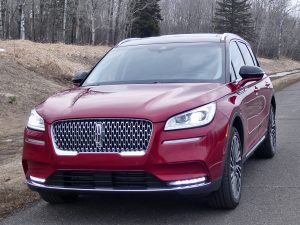
But in the space of one year, here we are evaluating — and praising — the third of three Lincoln SUVs all of which have carved out prominent places in the hierarchy of U.S. luxury sports-utility vehicles.
The new Navigator was deserving of high praise, and it was followed, barely a month ago, by a review of the entirely new Aviator, which I declared might be the best of U.S. luxury SUVs with its exceptional 3-row luxury as well as performance, tucked inside an extremely stylish exterior. And now, along comes the Corsair — Lincoln’s stylish example of what a compact, 2-row SUV can be, when a company puts its unrestricted mind to it.
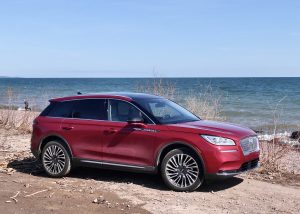
As someone who tries to be as objective as possible in evaluating any and all new vehicles, I had to admit the Navigator was bigger and heftier than I would choose, but its upscale luxury features made me realize why high-buck buyers would be drawn to it. The Aviator came wrapped in sheet metal that was attractively styled and the interior was loaded to the hilt with luxury pieces that made it expensive, but reasonably compact for a family that needed a 3-row SUV and still wanted something sporty and with surprising performance.
The Lincoln Corsair, on the other hand, fits like a glove my personal preferences for a compact SUV with adequate room for four or five and some baggage in its 2-row configuration, and it puts its tight and sleek styling to work in a sporty package that maneuvers easily, turns in a tight-circle u-turn, and will scat and run with the quickest of the compact SUVs. The competition is ferocious in the compact SUV realm, where Ford’s Escape is one of the standard bearers, and faces the likes of the Toyota RX4, Honda CR-V, Chevrolet Equinox, BMW X3 and numerous others, from virtually every manufacturer.
Since everybody seems to want an SUV these days, it makes sense that the majority of buyers might want to keep it compact when choosing, hoping to get improved fuel economy and making it easier to lure some performance out of smaller powertrains. The Corsair meets both ends of that bargain, delivering nearly 30 miles per gallon and still delivering some starch when you hit the gas.
Turbocharging is responsible for the compromise, with both Corsair engines, Ford’s 2.0 and 2.3-liter 4-cylinders gaining power from the forced-air feed of the turbos. The test-vehicle I drove was the loaded model, with a 2.3-liter turbo delivering a potent 295 horsepower and 310 foot-pounds of torque. That gives it about a one-second edge over the 2.0, with its 250 horses and 280 foot-pounds, in a 0-60 dash.
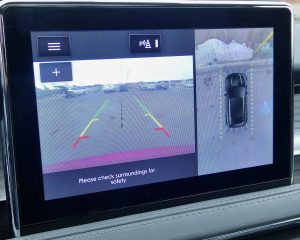
Taking a page out of Aviator’s book, the Corsair doesn’t have as flashy a dashboard design, but it does have similar bucket seats, with excellent support and 24-way power adjustability, with a curvaceous design that puts it up at the top of its class for comfort. The smooth leather seats have push-button heating and cooling ventilation, and add the therapeutic massage feature of its bigger siblings.
Lincolns have traditionally swiped the best features from Ford vehicles, and the Corsair wasn’t about to let the flashy new Escape get away with all its stuff, starting with its new and unique platform. The Corsair rides comfortably on the Escape chassis, which is firm in design which aids stability and sporty but safe handling. In its previous round of vehicles, Lincoln had the MKC sedan, which was nice, attractive, but was not an SUV.
The Corsair has the slightly taller stance and all-wheel drive, with all that high-end interior equipment and it is an SUV, retaining its flair for utility, even if compact and eye-catching.
One thing that takes a bit of getting used to is the shifter. Eliminating the console stalk to select gears gives occupants a bit more room, and Lincoln resists the temptation to go with the current and trendy norm of a rotating dial. Instead, on your first time inside and behind the wheel, you might spend a few minutes searching before you spot the location, just under the ledge of the center stack, where push buttons can activate reverse or drive or neutral to control the 8-speed automatic. Only problem, you can’t really see the buttons, so it helps if you know where they are.
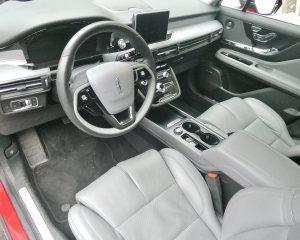
If the front buckets are supremely comfortable, and encapsulate you as if in a cocoon, the rear seats will slide to add to the quite roomy comfort in the rear. And it helps all the seats that the sunroof is one of those full, panoramic roofs that seems to open the whole ceiling to the outside.
Both models of the Corsair offer all-wheel drive, with the more basic model starting at about $39,000 and the upgraded Reserve model starting at almost $46,000. My test vehicle came loaded up with nearly $15,000 in optional equipment and packages, reaching over $62,000, which maintains its $6,000-$8,000 price status above the base model.
Among all those upgrades are some serious luxury touches, such as LED lights for added brightness in every application. Headlights, taillights and foglights are all LEDs, and it even has what are called approach lights, which give you a little lighted grid on the ground outside the doors to make sure you realize you’re getting into the right vehicle.
I’ve always been an advocate of getting the smallest vehicle that is big enough, and the Corsair is the perfect example of what I was getting at. It will do everything larger SUVs will do, but with the added convenience of agility and maneuverability in traffic and congested driving.
As for the styling, the Corsair has a lot of cues from the larger Aviator, with that distinctive Lincoln grille fitted in between the headlight fixtures, and a side view featuring contour lines blending into the sheet metal on both sides, and large, stylish alloy wheels, with dual exhausts. A nice added touch on the rear is a horizontal taillight that runs the full width of the vehicle and makes a distinctive impression on anyone approaching from the rear, or coming upon a parked Corsair.
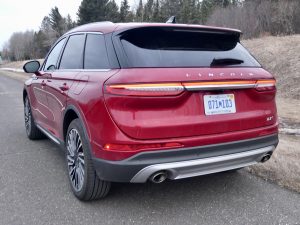
Built to slide, the rear seats offer comfort and added fold-down storage flexibility.
Maybe most people choose more compact SUVs because they cost less, but if things keep going the direction of the Corsair, we might have to start paying more to get all that styling into a smaller package.
Equinox gives Chevy a Premier compact SUV
Filed under: Weekly test drives, Features, Autos
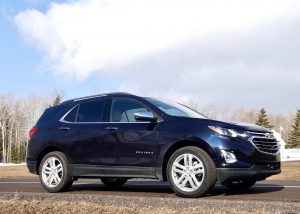
By John Gilbert
As the dreaded Coronavirus was about to foul up our springtime of 2020, I was just getting ready to enjoy the start of the NCHC college hockey playoffs, where the University of Minnesota Duluth was about to start its bid for a third straight NCAA title. I also had just finished a week-long road test with a 2020 Chevrolet Equinox Premier, a nicely styled and nicely sized SUV that is aimed at challenging the best of the compact SUVs — the RAV4, CR-V, Escape, Rogue, Cherokee, Tucson, Forester, and — my favorite — the Mazda CX-5.
Several things happened that caught me by surprise between my test drive week and the actual writing of this review. First, I was very impressed with everything about the Equinox, surprising because Chevrolet has seemed powerless to avoid fading away from the best of the rest. Second, I had read a couple reviews in car magazines, and my impressions of the previous Chevy SUVs and those test reports combined to make me apprehensive at best about the Equinox.
Another thing that happened was that the Federal Government has been very harsh — at least in its “Fearless Leader’s” dealings with General Motors. GM chief Mary Barra seems to have become one of President Trump’s favorite targets for his hit-and-run twitter/press briefing cheap-shots, dating back to his early days in office when he assumed all U.S. car-makers could simply shutter their overseas manufacturing plants and return to Detroit.
The most recent hit came after the last weekend in March, when the Coronavirus was tightening its deadly grip on all corners of the U.S., and Trump was live on television saying that GM had been dragging its feet when it came to aiding the nation, which was something he had become accustomed to in dealing with Barra.
It struck me as curious, because in the week before that outburst, I had read an account of how GM had worked out a partnership with Ventec Life Systems, a small company that makes ventilators, which have become so vital to helping afflicted patients keep breathing. GM engineers collaborated with Ventec on how they could convert a GM plant and find the materials to help Ventec make 10 times more than the 200 ventilators it normally makes each month.
In a matter of four days, the plan had been mobilized. And then Trump took his private little stage on Friday, March 27, 2020 and said he had activated an emergency plan that would force GM to help.
To their credit, although reportedly outraged, GM officials made the judicious move to keep on working around the clock to create ventilators without any comment on the accusation, and resisted making the link that Trump might have been hustling to attain his daily dose of praise, figuring if he hurried, he could take credit for forcing General Motors to start doing what it had already been doing for most of a week. Shortly after criticizing difficulties with GM “under Mary,” Trump cut off a daily press conference question about GM’s involvement and praised the company and its chairman for a “great job” of helping, stopping predictably short of apologizing for his awkward statement three days earlier.
Ford and FCA (Fiat Chrysler Automobiles), incidentally, also have been helping the cause. Ford, for example, has partnered with Minnesota’s 3M, and respirator-maker GE Healthcare, to simplify the process by which GE Healthcare can greatly increase its production of respirators, aiming at 100,000 per week.
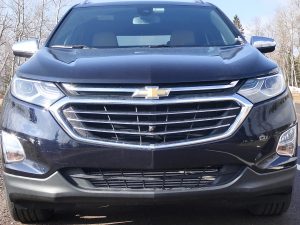
Meanwhile, back out on the road, I found the Equinox a far more worthy family hauler than a Motor Trend review of it indicated. Those car magazine hot-rodders tend to pound cars much harder than normal consumers might, so when they ripped the Equinox for not cornering like a Miata, I took it with a grain of salsa.
In testing a vehicle’s handling, what one driver might find too-soft in corner swaying is another driver’s comfortable ride; just like one driver’s firm and solid cornering might be another’s harsh and uncomfortable ride. The Equinox came in eighth and last in the Motor Trend comparison, but Chevrolet needn’t feel too bad; the magazine didn’t even bother to include a Ford Escape — another compact SUV I like a lot.
In the magazine’s test, the CR-V was first, the Mazda CX-5 second. Without question, the Equinox is no race car, although the magazine’s criticism of the car’s safety devices and poor-quality interior ingredients might be mostly due to the fact that it was not up to the standards of my test vehicle — which was the optional Premier, with its top-of-the-line features.
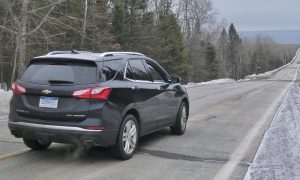
It was far better equipped to corner and display directional stability, and its numerous other interior and safety parts were much appreciated. The leather seats, lane-departure alert, lane-keep assist, rear-park assist and camera, heated and ventilated front buckets, heated steering wheel and adaptive cruise control are significant upgrades for a loaded, as-tested sticker of a reasonable $38,545.
Power in the test Equinox came from Chevrolet’s new-age 2.0-liter turbocharged 4-cylinder engine with a smooth-shifting 9-speed automatic transmission, while many competitors have a CVT (continuously variable transmission) that tends to drone and frustrate in equal parts. The 9-speed worked smoothly in coordination with the all-wheel drive in the Equinox.
The LED head and tail lights and the keyless start system are also nice things sometimes rare on compact SUVs.
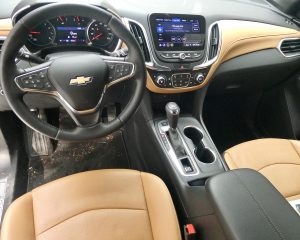
Each time I walked up to the Equinox, I was impressed by its styling, with its swept-back lines that blend the rear pillar into the rear of the vehicle. and I think it stands out from the pack because of that.
Chevy also makes the Traverse, which is a little bigger, but very similarly styled, with a V6 for power and three rows of seats. That makes it your choice: if you want and need a larger vehicle with a larger engine, or can get by with the agility of the smaller Equinox and appreciate improved economy. It was perfect timing that put the Equinox Premier with its push-button-activated all-wheel drive came into my hands at the precise time when it seemed that General Motors and Chevrolet needed and deserved some defending from unfair criticism from the White House, coupled with my impressions of the vehicle itself.
It has been a Chevrolet tradition when it makes cars to offer a top-of-the-line model, a mid-range model for features and expense, and a less-expensive bargain model that may be without a lot of appreciated features. Other companies cut corners similarly, but nobody else is guilty of stripping the true value items from its less-expensive models. That’s one area where the Japanese, Germans and Koreans are far ahead.
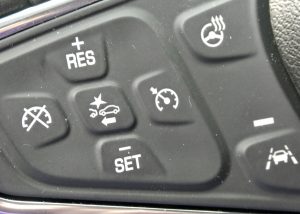
The Premier version of the Equinox matches most competitive compact SUVs, although the audio system was nothing special. It did have wireless charging for cell phones, and the optional OnStar system adds security. In its quest to load up remote switchgear on the steering wheel, though, I found that every time I cranked the steering wheel to get into or out of a parking spot, I inadvertently hit the little switch above the grip location and became conditioned to cancelling out the OnStar lady as she attempted to plan my rescue.
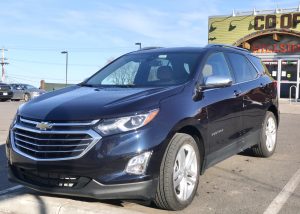
Over the weekend, various car dealerships hurting for sales came out with enormous ad campaigns. I caught a Chevrolet ad that screamed out about the 2020 Equinox being offered for 0-percent down, and 0-percent interest for 80 months, with the company paying the first four months-worth! That made the timing still better, because it seems as though Chevrolet is virtually giving away its Equinoxes.
Just remember, you may like it a lot or dislike it completely, but it all comes down to a driver’s opinion. And keep in mind that not all compact SUVs are created Equinox-ly.
Always room for bargain Jag-you-are
Filed under: Weekly test drives, Autos
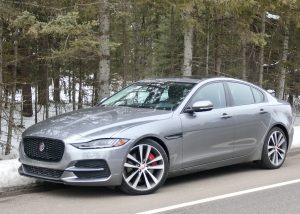
Ireland may be a long distance from Castle Bromwich, U.K., where the Jaguar XE is assembled, and maybe the Irish don’t always embrace the British, but when the week of St. Patrick’s Day coincides with the world closing up all our restaurants and pubs — and arenas, stadiums, movie theaters and other gathering places — for the Coronavirus pandemic in mid-March of 2020, we can still pause and give thanks, and hope, that there will always be a Jaguar.
We’ll even pronounce it “Jag-you-are,” as the British intended it to be, because, after all, they invented our language.
If you couldn’t go to a St. Patrick’s Day Parade, even, then maybe you could at least drive a Jaguar XE P250 S around for a while. Imagine it in a beautiful dark green — think traditional “British Racing Green,” but anything an Irish shade of green would work to celebrate.
Turns out, the test car I was able to drive before St. Patrick’s Day was a luxurious shade of “Eiger Grey” (with “grey” also being the preferred UK spelling) rather than green, but I could accept that, even though I happen to be about 75 percent Irish.
Times are tough in the auto selling business, all over the world, and Jaguar is among those hurting to sell more. But under the ownership of Tata Motors in India, the British pride is reflected in the newly restyled XE sedan, which I found dazzling to look at from every angle and to show off to anyone on my appointed rounds in and near Duluth, Minnesota. That includes the still-snowy and chilly North Shore of Lake Superior.
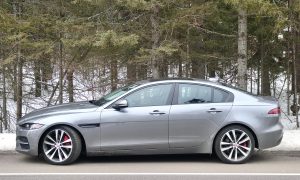
There are so many beautifully styled midsize sedans on the market that it is difficult to find any that aren’t, any more, which is a good thing. But Jaguars still hold a special place in the hearts and minds of car fanciers the world over, and the new XE stands out as one of the best bargains in the luxury sedan market. That may be the “glass-half-full” version, compared to those lead-footed critics who complain about the obvious drop in power from the previous supercharged V6.
When you do your first walk-around, and admire the formal grille, the gently curving lines on the sides, the sporty rear with its protruding exhaust tubes, keep in mind that this is a 4-door sedan, not a sports coupe. Consider the whole fleet of Jaguars, up to and including the larger XF sedan, which costs between $50,000 and $75,000, and he XJ, which runs from the mid-$70,000 range up and over $125,000, you have to guess that the slightly more compact Jaguar XE must cost somewhere over $50,000.
Surprise. The base Jag XE P250 S lists for $39,900, and everything comes equipped on the car, which means adding on the destination and delivery puts it up to a mere $40,895 sticker.
If you have always admired Jaguars, you will find that modest price a bargain. There are some places Jaguar has cut back on expenses. For one, the powerful, extravagant supercharged V6 has been discontinued, taking its voluptuous sound and its 380 horsepower with it. But Jaguar has countered very effectively, with a 2.0-liter 4-cylinder, turbocharged to develop 298 horsepower and 295 foot-pounds of torque.
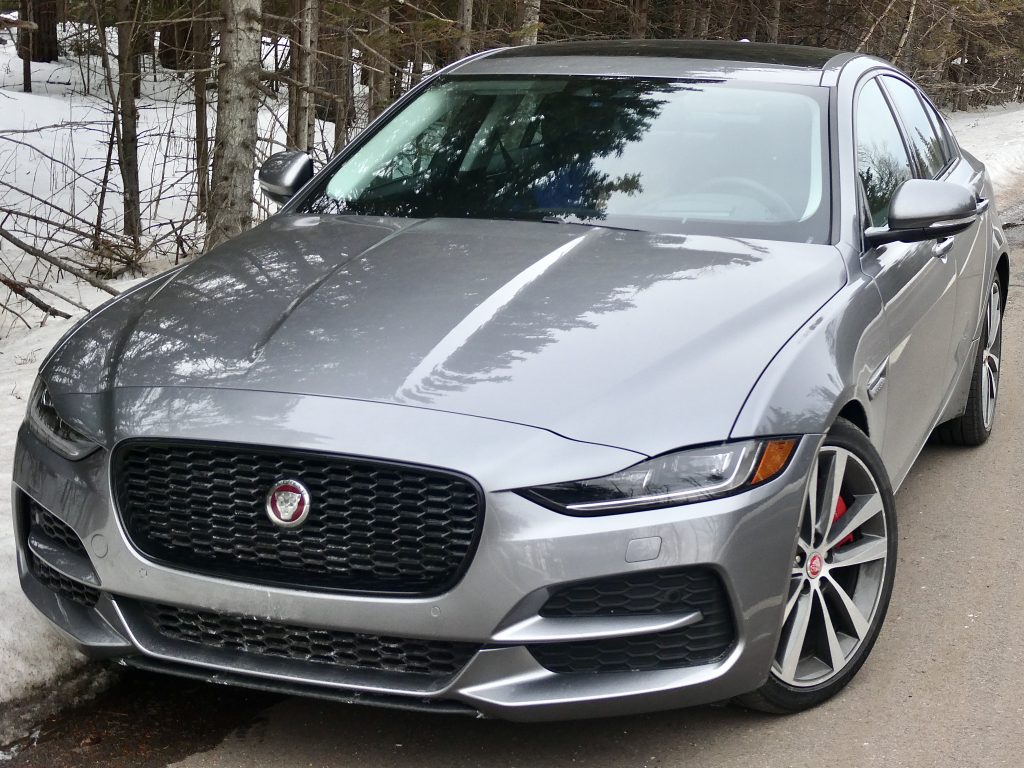
That’s a solid and impressive amount of power coming from a 2.0 engine, proving again how effective turbocharging can be to extract power from a diminutive batch of displacement. No, it’s not nearly 400, but in this era of economy, efficiency and expense — the “three E’s” of modern car-building, it is more than adequate. I’ve had experience with that engine before — as well as the supercharged V6 — in smaller models of Jaguar sibling Range Rover SUVs, where it handles all duties efficiently. So in the XE sedan, it dots all the right letters.
The powertrain earns extra points for the 8-speed ZF transmission that shifts smoothly and helps extract and apply that power. That powertrain used to come in two doses of power, with 247 horsepower in base form. but Jaguar wisely gives only the 296-horse version to the XE.
One place I do wish Jaguar had not compromised is that the XE comes in both rear-wheel drive and all-wheel drive, and the test vehicle had rear-drive only. In Minnesota winters, especially on Duluth hillsides, AWD is much preferred, and if you’re going to allow just two wheels to move your car, you’re best suited to having it be the front wheels, not the rears, which can defy all sorts of electronic traction, stability and other safety and steering gadgets to still enjoy trying to pass the fronts when you’re on ice.
Still, if you’re shopping for a Jaguar, the AWD option isn’t prohibitive in cost. And it probably doesn’t detract too much from the EPA estimated fuel economy of 34 miles per gallon in highway driving. Try that on your supercharged V6!
The week I drove the Jaguar XE sedan, we got lucky and were free of blizzards and nasty ice patches, which allowed us to get wherever we wanted with rear-derive, thanks more to Mother Nature than the Jag’s road-sticking tricks.
At $40,895, the XE hasn’t left much else unchecked when it comes to driving features, to enhance both sporty driving and the traditional feel of a luxury car, including something called JaguarDrive, selectable driving modes you can click from comfort to eco, to rain/snow, to dynamic, with dynamic holding revs longer and firming up your steering feel.
All the contemporary connectivity stuff is on board, whether Apple Car-Play, or Android, and you have the also obligatory safety features, such as rear camera, parking assist, blind-spot detection, and lane-departure warning as well as lane-keeping assist.

There is also All Surface Progress Control. You’ve got to love the Brits for coming up with their own name for trying to make their car hold the road. Progress Control? Never thought of that. It also has torque-vectoring, which uses computerized braking to correct your steering vector if the system senses that you are not tracing your projected curve judiciously enough to stay in your lane.
I also liked the ebony Windsor leather seats, and those impressive front buckets are heated and cooled and adjust 18 ways for both driver and passenger, to assure your comfort. That includes your ears, which are embraced by an 825-watt Meridian surround audio system.
Build quality of the XE is impressive, and the body that is now 75 percent aluminum intensive — or “al-you-MIN-ee-um” as the Brits call it — is aided by the lightness and strength of the alloy. Under those curvaceous lines there are exclusive 19-inch alloy wheels controlled by double-wishbone suspension in front and Integral Link in the rear. Double wishbone is simply the best, and you will believe it with the quick agility of the steering and the stability without jolts in any cornering attitude.
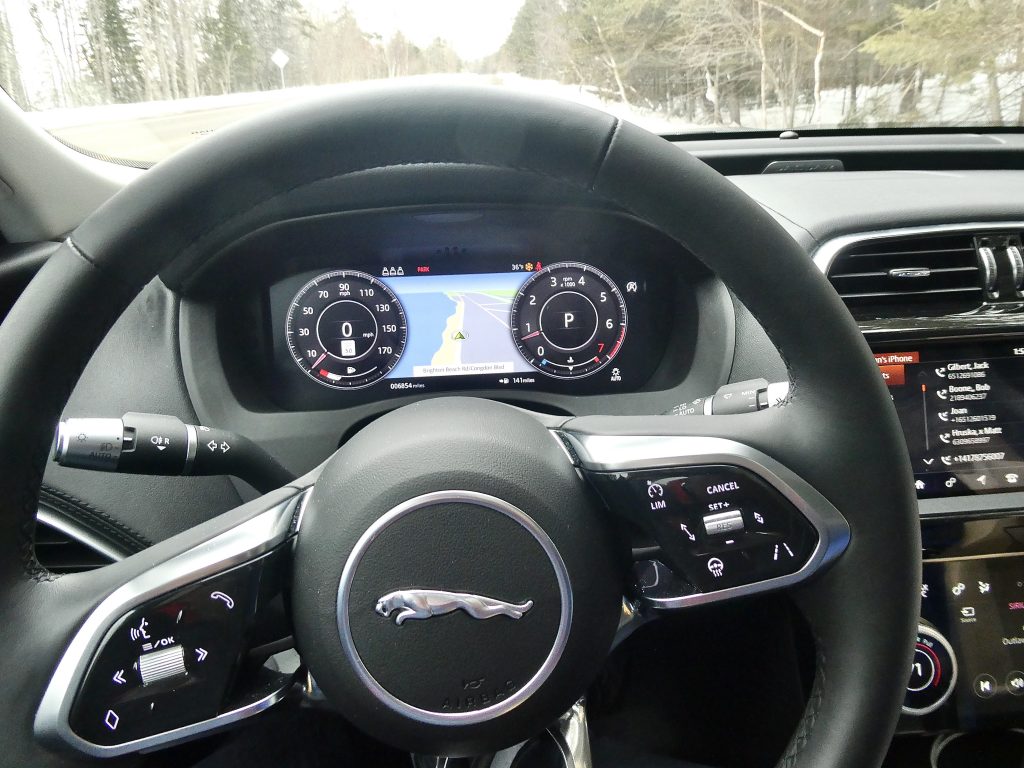
Inside, where you live after admiring your Jaguar XE upon approaching, the restyled exterior has been more than matched by the interior, where a new layout of instrumentation and fabrics cover every surface. Jaguar has even enhanced the 10-inch touch-screen by adding a redundant screen between the two large major instruments, the speedometer and tachometer, when you toggle up the assorted options to be located on your instrument panel. It is not as crisply sharp as Audi’s, which uses Google Maps for true satellite showings of your territory, but it is soft and artistic to view, and frees up the touch screen for other things that need touching.
LED headlights light up the night and have auto-dimming, the outside mirrors are heated against ice and frost, the rear seats are split to fold down, while an impressive ambient light show accents the inside and as you get in and out. A wireless charger is impressive, also a head-up display visible through your windshield.
The more I think about it, the more I’d like to see an XE in luck-o’-the-Irish green. Of course, we hope that this goofy worldwide virus afflicting us all will vanish just as swiftly as St. Patrick’s Day has come and gone. There will always be another St. Patrick’s Day, thankfully, just as there will always be a Jag-you-are.
Mercedes GLC 300 conquers new world
Filed under: Weekly test drives, Autos
By John Gilbert
The stereotypical image conjured up is of big, regal sedans or low, sleek sports sedans or roadsters, whenever the name Mercedes-Benz is mentioned. But it’s a new era, and while the Mercedes sedans and sports cars are sleeker and higher-tech than ever, the ideal vehicle for a changing world might be the GLC 300.
A year ago, Motor Trend named the GLC its SUV of the year, because the new vehicle was built up for a bit more interior room as a utility vehicle worth the name, combined with the sportiness demanded by contemporary drivers who want the extra panache of the Mercedes aura.
I got a chance to live with a 2020 Mercedes GLC 300 4Matic SUV for a week a while ago, and suddenly my memory came alive about why I decided I liked the small Mercedes SUV better than any of the fabulous cars from the Stuttgart specialists.
And that takes nothing away from the Mercedes cars, because how can anyone fault any of them? But as U.S. drivers prove their changing preferences with their checkbooks, Mercedes has a full batch of large and midsize SUVs for selection, and nestled in there, the company has placed the GLC.
The formula only makes sense. If buyers want the assets of front-wheel drive for maneuvering and handling in all weather, then why not trim the midsize model down to compact size, making sure there is adequate front and rear head and legroom, and storage space, then lighten it wherever possible and give it snappy, sporty handling and steering. Arm it with a high-performing but small engine, with a transmission that can make it sing, and maybe paddle shifters to allow sporty control of those shifts.
With that, here is the GLC 300, where the number doesn’t relate to the engine displacement the way it used to with Mercedes. In this case, the GLC has a 2.0-liter 4-cylinder with a turbocharger. The turbo is tuned to reach 255 peak horsepower and torque peaking at 271 foot-pounds. That may not sound like much if it were a big, bulky vehicle, but in the lean and mean GLC it’s plenty.
The 9-speed automatic can shift every well by itself, but also has those paddles to allow you to put it in the ratio you want for the situation. And with nine gears, it often might have shifted up too far too soon to give you toe-tapping torque when you need it. Paddle your left fingertip down a couple and you’ve downshifted from ninth to seventh for cruising down an exit ramp, and you can hold it in the lower gear with another couple flicks.
Up in the North Country, on the North Shore of Lake Superior, such controllable shifts are ideal for the packed snow ind slick ice that can cover the highways and hills. But I want to stress another feature of the GLC 300 that surprised me at first, then impressed me — a lot.
We were driving to the Chicago Auto Show, cruising in on Interstates through Milwaukee and then south to Chicago. I had set the destination for the hotel we had registered for, a Suite2 by Hilton, that was brand new and only a couple blocks by skyway from McCormick Place, where the show was. I wanted to skip the tollways that help Illinois folks pay for their highway repairs, even though I appreciate how smooth they are, compared to Minnesota’s frost-heaved pavement.
As we got right to the Chicago area, we had to swing in on the freeway to get to our destination, but ahead, we saw a fog-like greyness that was puzzling. As we got closer, we also saw all kinds of taillights and brake lights. It was snowing, causing the dusky grey, I got over into the right lane of the five lanes we were on, and we were amused that so many people seemed terrified of what we considered a light dusting of snow. And we kept our eye on the nav screen, where a neat diagram of all five lanes showed us exactly where we were and where we should be. I was right there, second lane from the right.
But traffic was thickening and stopping in some lanes as we approached an exit still 5 miles from our destination. Suddenly, my son Jack, my assistant, photographer, and co-pilot, said, “It’s telling us to exit here!”
At a glance, I saw he was right, with the solid blue line that was us, veering up that exit ramp. At a glance in the right side mirror, I realized we had a clear lane to our right, so I promptly swerved, and then swerved again to make it onto the exit ramp, smooth as if it had been planned. I was sure it was in error, but when we got up to the cross-street, we were greeted with flashing lights. A small accident had clogged the intersection a bit, but we were clear. I glanced one more time, and the nav screen did NOT say we should turn left, so having to decide in a millisecond, I continued straight across the street and back down the on-ramp.
As we entered back onto the congested freeway, I felt a little guilty that we had passed about 500 cars and easily merged back into the right traffic lane and continued smoothly to our destination.
Now, I would never suggest that anyone should drive that way, exiting and re-entering just to beat the system, but, hey! The nav lady told us to do it! After we got to our hotel, I started to wonder, and while I have no way to prove it, I believe the guidance system actually sized up the congestion and found a logical way to get around it.
Is that possible?
Well, whether intentional or not, we suddenly felt as though the feature-packed Mercedes GLC 300 had adopted us as its own.
Another surprise is that the sticker price shows $44,500 for the basic GLC 300, and adding virtually every available optional and safety package ran the price up to $60,575, it was still a bargain. The surprise to me was not that the vehicle cost $60-thou, but that you could get it for less than that if you took away some of the items, such as driver assistance, parking assistance, exterior lighting, or multimedia packages, and lower the price to nearly bargain proportions.
Included in those packages are a lot of impressive things, such as high-performance all-season tires, panoramic sunroof, active steering and distance control. active lane change, evasive steering assist, back-up camera with cross-traffic alert and warning.
In short, you can pretty much drive at ease, because your Mercedes is watching out for you. No, you can’t relax, and it doesn’t drive for you, but it allows you to focus on what’s really important on the road ahead, confident that the GLC 300 will alert your, guide you and maybe prevent you from any mistakes that might cause a problem.
And if it suggest you are convinced to exit ahead of plans, and find you’ve cut off about 20 minutes of congested driving, well, you can live with that.
Minnesota’s big show promotes Truck Summit
Filed under: Features, Autos
By John Gilbert
Trucks, trucks and more trucks. The Minneapolis-St. Paul Auto Show has trucks of all shapes and sizes, from monster diesels to compact crossovers, and since the definition of a truck has been shattered by the new and expanded definition, we’re going to have to concede that the show promoters were correct in claiming it deserved to hold its “Truck Summit” because 82 percent of all vehicles sold in Minnesota are trucks.
That can include the boatload of compact crossovers, which actually make the most sense as we transition fully from sedans to trucks, but the full array of trucks are pickups, SUVs, crossovers on down to tiny vehicles with all-wheel drive. But to many Minnesota buyers, trucks mean boat-hauling pickups.
They called it a Truck Summit, as if show promoters, who are operate the big Convention Center extravaganza through this weekend, March 14-15, have an exclusive here, with trucks taking over for cars in daily lives of normal consumers. Of course, trucks are taking over everywhere in the U.S., although that 82-percent figure is pretty compelling.
The fascinating part of our fascination with all things truck is that every manufacturer claims superiority, sometimes of the same statistic in the same critical area of comparison. You will hear Ford proclaim the F-150 the leading seller in the country, and you will hear Chevrolet claim the Silverado is the top seller in Minnesota, while the folks at Ram just sit back and smile about their own success in the marketplace and their new designation — by no less than the cars.com website, which declared the Ram 1500 pickup its “Luxury vehicle of the year” for 2020.
But the truck folks also all claim the unregulated advantage as having the most towing capacity, the largest hauling tally, and the most power of all. Now, they all can’t be right of course, but we’ll leave the hotly contested place up to the consumers who can come to the auto show, at the Minneapolis Convention Center, and kick the tires of every car and truck sold in the area, and make their own decisions.
We at NewCarPicks.com will just try to offer the guidance of having driven most, if not all, of the new trucks, and cars as well.
The National Truck Summit kicked off the auto show by putting on over three hours of discussions with industry executives. Jay Sacket talked first; he’s the executive program manager of Toyota. A panel discussion followed with Sacket joining JATO Dynamics president Matt Weiss, and Erin Klepaski, senior vice president of Auto Sales Alliance. Next up was Tim Stoehr, regional product line manager of Ford, then Marjk Boyadjis, from Global Technology. And finally, interiuor designer Ryan Nagode from Ram.
The fact that trucks are taking over our hearts, as well as our bank accounts, is not news. It was news 10 years ago, and 5 years ago, when it was first challenging sedans in sales, and long before we see the figures that show the RAV4 now beats out the Camry and Corolla as Toyota’s top seller, or that the CR-V tops the Accord and Civic as Honda’s leader.
The news now is that while trucks — and SUVs — hold a clear majority over cars in total sales, the figure of 82 percent in Minnesota is shocking enough to surprise even my good friend David Boldt, from Texas, who is from a state where there are dealerships that sell only trucks, with no cars. Boldt wrote that no other state comes close to Texas in the purchase of trucks, with the Lone Star State selling over 100,000 Ford F-150s, in fact.
I’ve always maintained that our pickup culture is traditional. Chevy guys don’t buy Fords, Ford guys wouldn’t consider a Chevy, and while they’ve been arm wrestling, Dodge’s Ram brand has made the biggest impact on the truck market in the past year.
The latest redesigned Ram 1500 stormed past the Silverado for the first time ever to stand a solid second only to the F-150 in pickup sales and stature, and since all of the Big Three’s big trucks are similar enough in towing and hauling to all claim superiority, there must be something special about the Ram. And there is. It’s the interior.
When Fiat took over Chrysler to form FCA, for Fiat Chrysler Automobiles, the Italian company pushed a stylish flair through the entire corporation, and while Jeep has benefitted greatly, Ram trucks have soared with interiors that rival luxury cars in their attention to detail and the refinement of fabrics and trim features.
There is still time to take a drive down Interstate 35 and take in the auto show, and to whet your appetite, we’re supplying an array of photos of what you might want to check out.
First off, the Ford pickup remains the king, and we’re showing the Super Duty, bigger than full size, as the king of the kingdom. The GMC 2500 DuraMax diesel — the one with the trick tailgate that features a drop-down step for easy access, the center-piece for folks in the TV commercials to have their jaws drop in amazement — meaning they haven’t seen a Ford in the past decade, which has had that same tailgate feature and includes a locking upright post as a grip handle. Next up is the Ram, and we’re showing the monster Ram with dallies and all and a 6.4-liter Hemi. With it, you’ll see the rich leather interior of the Longhorn trim package, flanking the foot-tall navigation screen that is the size of a full iPad and just as useful.
The Chevy Silverado prances into view in bright red, looking good even if it has slipped to third place among the Big Three.
Midsize trucks have made a big comeback, too, and the reliable Toyota Tacoma remains a favorite for fitting just about anything you might need a truck for. This one is the TRD-Pro, which is a cut above the excellent TRD, and you can tell it by the huge snorkel that rises up along the right front pillar to remind you that when you thrash through desert sane, you needn’t worry about sand
getting into the air intake. Of course, it also might work in snow, and whether it does or doesn’t, I thought the picture after a snowstorm was worth it.But don’t overlook the very competitive Honda Ridgeline, as well.
Where, in your truckscape, does the Jeep Wrangler fit? Is it a car, a truck, an SUV, or a unique vehicle capable of off-roading to places no sane driver would take another vehicle?
Cadillac brings out the XT6, a stylish SUV-like wagon with V6 power. For power, the Dodge Durango is a large SUV with SRT Hemi treatment for high power in a versatile vehicle. And Ford’s newest versions of the Explorer SUV and the compact Escape SUV also make the show.
And just so you see we haven’t forgotten traditional excellence, here are a pair of newly redesigned Range Rovers — the sleek-roofed Evoque, and the smooth Velar, both expensive, but loaded with interior features that prove, conclusively, that trucks have become the new luxury sedans.


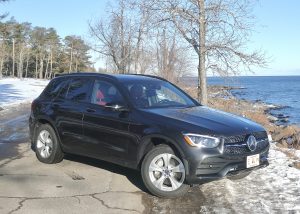
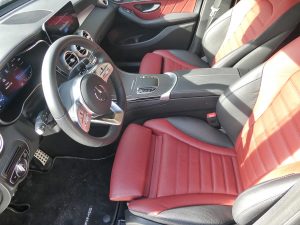
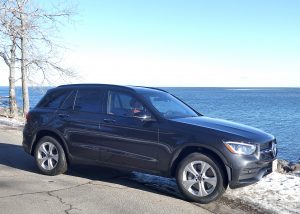

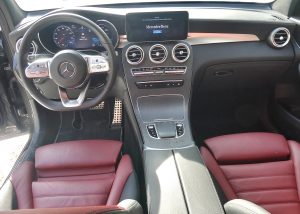
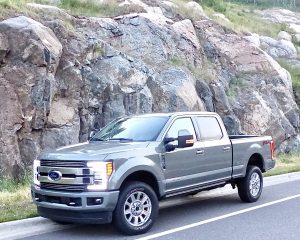
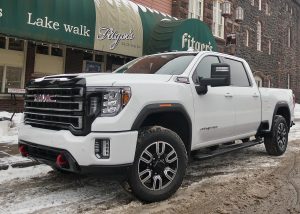
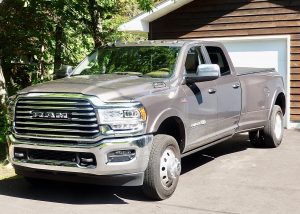
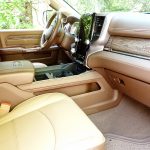
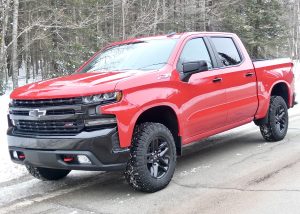
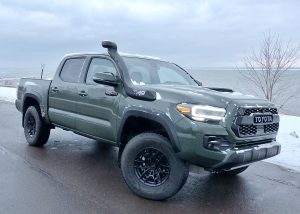
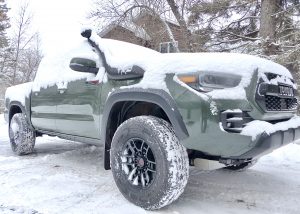
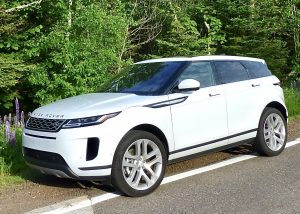

 John Gilbert is a lifetime Minnesotan and career journalist, specializing in cars and sports during and since spending 30 years at the Minneapolis Tribune, now the Star Tribune. More recently, he has continued translating the high-tech world of autos and sharing his passionate insights as a freelance writer/photographer/broadcaster. A member of the prestigious North American Car and Truck of the Year jury since 1993. John can be heard Monday-Friday from 9-11am on 610 KDAL(www.kdal610.com) on the "John Gilbert Show," and writes a column in the Duluth Reader.
John Gilbert is a lifetime Minnesotan and career journalist, specializing in cars and sports during and since spending 30 years at the Minneapolis Tribune, now the Star Tribune. More recently, he has continued translating the high-tech world of autos and sharing his passionate insights as a freelance writer/photographer/broadcaster. A member of the prestigious North American Car and Truck of the Year jury since 1993. John can be heard Monday-Friday from 9-11am on 610 KDAL(www.kdal610.com) on the "John Gilbert Show," and writes a column in the Duluth Reader.